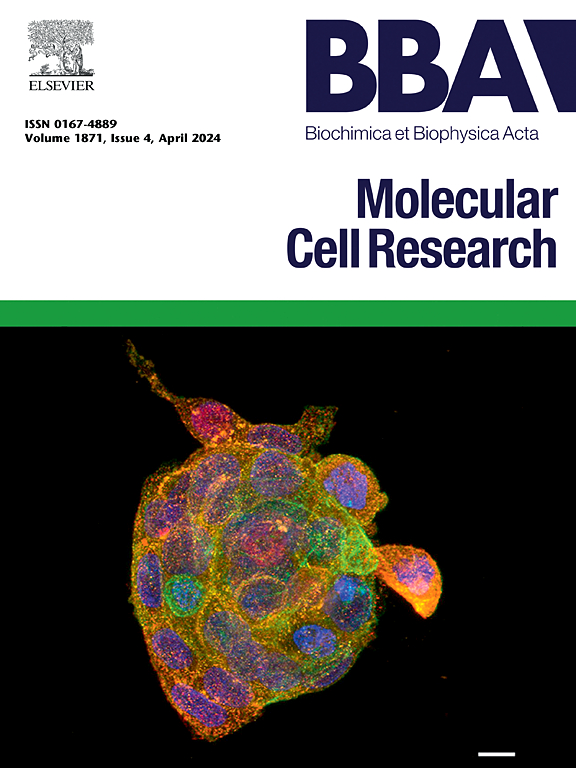MicroRNA-22-3p suppresses hair regrowth in androgenetic alopecia by targeting chloride intracellular channel 4
IF 3.7
2区 生物学
Q1 BIOCHEMISTRY & MOLECULAR BIOLOGY
Biochimica et biophysica acta. Molecular cell research
Pub Date : 2025-07-31
DOI:10.1016/j.bbamcr.2025.120033
引用次数: 0
Abstract
Androgenetic alopecia (AGA), the most prevalent form of patterned hair loss, manifests through androgen sensitivity, age-dependent progression, and genetic predisposition. Emerging evidence highlights microRNAs as critical post-transcriptional regulators in hair follicle pathophysiology. This study used human hair follicle stem cells (HFSCs), hair follicle samples of AGA patients and AGA mouse model to explore the role of miR-22-3p/CLIC4 signaling in AGA. A significant rise in miR-22-3p expression was observed in balding hair follicles of grade 5 AGA patients. Then we identify chloride intracellular channel 4 (CLIC4) as a novel target of miR-22-3p and CLIC4 is markedly low expressed in balding hair follicle of AGA patients. Functional studies demonstrated that knockdown CLIC4 (shCLIC4) impaired HFSCs proliferative capacity and disrupted sonic hedgehog (SHH) pathway activation, evidenced by decreased Gli1 and Gli2 transcriptional activity. These findings establish the miR-22-3p/CLIC4 axis as a novel regulator of hair follicular miniaturization, proposing CLIC4-mediated SHH modulation as a potential therapeutic target for AGA intervention.
MicroRNA-22-3p通过靶向氯离子胞内通道4抑制雄激素性脱发的毛发再生
雄激素性脱发(AGA)是最常见的斑秃形式,表现为雄激素敏感性、年龄依赖性进展和遗传易感性。新出现的证据表明,microRNAs在毛囊病理生理中是关键的转录后调节因子。本研究利用人毛囊干细胞(HFSCs)、AGA患者毛囊样本和AGA小鼠模型,探讨miR-22-3p/CLIC4信号通路在AGA中的作用。在5级AGA患者的秃顶毛囊中观察到miR-22-3p的表达显著升高。然后,我们确定了氯离子细胞内通道4 (CLIC4)作为miR-22-3p的新靶点,并且CLIC4在AGA患者的秃顶毛囊中明显低表达。功能研究表明,敲低CLIC4 (shCLIC4)会损害HFSCs的增殖能力,破坏sonic hedgehog (SHH)通路的激活,这可以通过Gli1和Gli2转录活性降低来证明。这些发现确立了miR-22-3p/CLIC4轴作为毛囊小型化的新调节因子,提出了CLIC4介导的SHH调节作为AGA干预的潜在治疗靶点。
本文章由计算机程序翻译,如有差异,请以英文原文为准。
求助全文
约1分钟内获得全文
求助全文
来源期刊
CiteScore
10.00
自引率
2.00%
发文量
151
审稿时长
44 days
期刊介绍:
BBA Molecular Cell Research focuses on understanding the mechanisms of cellular processes at the molecular level. These include aspects of cellular signaling, signal transduction, cell cycle, apoptosis, intracellular trafficking, secretory and endocytic pathways, biogenesis of cell organelles, cytoskeletal structures, cellular interactions, cell/tissue differentiation and cellular enzymology. Also included are studies at the interface between Cell Biology and Biophysics which apply for example novel imaging methods for characterizing cellular processes.

 求助内容:
求助内容: 应助结果提醒方式:
应助结果提醒方式:


